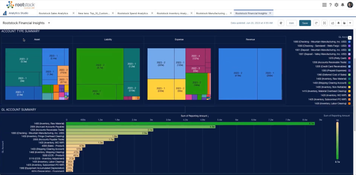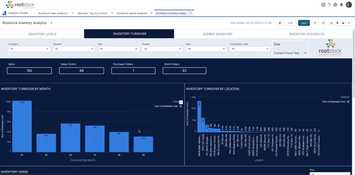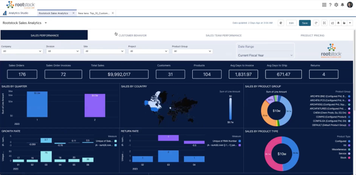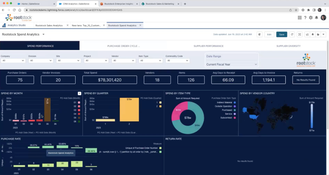Rootstock Cloud ERP
Cloud ERP software for manufacturing, distribution, and supply chain.
Product Overview
Rootstock Cloud ERP is a manufacturing, distribution, and supply chain software on the Salesforce Cloud Platform. The software integrates CRM and accounting with sales order management, inventory control, purchase order tracking, and standard cost accounting. Rootstock also provides intelligent supply chain planning through its low-code, customizable platform.Pros
- Designed with inventory and manufacturing in mind
- Built on Salesforce platform
- Low-code customization options for process flows and workflows
Cons
- Importing excel files for reporting can be troublesome
- Reliance on external financial package (Financial Force)
- Long process lengths requiring more steps and clicks
Target Market
Rootstock ERP is best for the manufacturing, distribution, and supply chain industries. It offers specialized solutions for sectors like aerospace, canna-business, and high-tech electronics.Rootstock Cloud ERP Features
- Sales Orders: Facilitates order entry from web stores, EDI systems, or Salesforce quotes. Supports product configuration and integrates with eCommerce and product configurator apps.
- Material Requirements Planning: Automates purchasing activities and delivery schedules. Supports build-to-order, build-to-stock, engineer-to-order, configure-to-order, and project-based requirements.
- Scheduling and Capacity Planning: Features drag-and-drop capacity planning and scheduling. Enables tracking of orders, materials, and components throughout production.
- Bill of Materials: Defines manufacturing and subcontract assemblies in the BOM. Includes engineering change control (ECO) for additional approval processes and change management.
- Purchasing: Manages direct and indirect materials, services, and supplies.
- EDI Systems Integration: Connects to EDI systems for streamlined data exchange.
- Multi-Division Support: Supports multiple divisions, plants, and warehouses.
- Manufacturing Cost Accounting: Provides standard or average cost accounting.
- Shop Floor Control: Tracks real-time shop floor activities with visibility and reporting.
- Inventory Control: Offers transaction information, ABC category analysis, and cycle counts. Allows inventory updates by location, lot number, serial number, or project.
- Project Control: Collects costs across all project aspects, including inventory by project.
- Lot or Serial Control: Supports item traceability by source or process.
- PLM Integration: Integrates with PLM solutions like Arena.
Rootstock enterprise apps share data and integrate with other native apps like Salesforce CRM and FinancialForce Accounting for a complete enterprise cloud-computing solution.
Inventory Control
Rootstock’s inventory control module is designed to streamline stock management. It includes features for item inventories, valuation, and policy setting, such as lead time and MRP planning. This module also supports direct material item purchase requisition maintenance and supply-demand review, enhancing material planning and inventory management.
Item master maintenance automatically sets part policies and attributes. Inventories are tracked by item and location within divisions and sites, with specific attributes for lot control, serial control, and backflush locations. An audit trail for material movement and labor transactions is also available.
Lot & Serial Control
This feature manages item lot and serial numbers through various functions like purchasing receipts, inventory, shop floor control, and sales order fulfillment. It ensures accurate tracking and compliance with inventory standards.
Manufacturing Cost Control
Rootstock offers cost accounting with standard or weighted average costing. It tracks eight cost elements, including material, labor, and overhead costs, with variance calculations in a standard cost environment. Rootstock’s system also integrates a detailed manufacturing accounts chart for financial tracking.
Material Resource Planning (MRP) Module
The MRP module uses sales orders and forecast demands to generate planned supplies for manufactured and purchased items. It supports multi-division and multi-site planning, managing resources and inventory across various locations.
Multi Division - Multi-Site
This functionality caters to manufacturing companies with multiple locations, offering inter-division and inter-site capabilities. It allows efficient planning and transfer of materials across different locations, maintaining division-specific production and inventory.
Product Lifecycle Management (PLM) Integration
Rootstock integrates with PLM systems to automate product data transfer, ensuring current and accurate manufacturing configurations. This integration enhances manufacturing efficiency and product lifecycle management.
Production Engineering
This includes item master maintenance, bill of material maintenance, and engineering change control. It helps manage direct material item characteristics and tracks revisions and changes effectively.
Project Control
Rootstock project control adds an extra layer to inventory tracking, planning, and costing by project. It’s suitable for discrete manufacturing operations, allowing detailed project-level management within various manufacturing modules.
Purchase Order Management
This feature streamlines the entire purchasing process from requisition to material receipt, including vendor performance tracking and reporting.
Sales Order Management
Rootstock sales order management facilitates the processing of customer sales orders. It integrates seamlessly with Salesforce and other platforms to manage customer and product data efficiently.
Scheduling & Capacity Planning
This feature manages work order operations’ schedules to meet MRP requirements. It includes advanced scheduling algorithms and capacity planning tools for efficient production management.
Shop Floor Control
Rootstock shop floor control oversees the entire lifecycle of work orders, from routing maintenance to work order completion. It includes comprehensive functionalities for managing work operations and costs.
Pricing Details
- The Growth plan starts at $100/user with shop floor and limited licenses available for function-specific users.
- The Advanced plan starts at $145/user and includes all license types as the Growth plan.
- The Enterprise plan has custom pricing; it’s recommended to contact Rootstock directly for more specific details.
Video Overview
Product Overview
Developer Overview
Related Products
User Reviews of Rootstock Cloud ERP
No reviews have been submitted. Do you use Rootstock Cloud ERP? Have you considered it as part of your software evaluation process? Share your perspective by writing a review, and help other organizations like yours make smarter, more informed software selection decisions!









